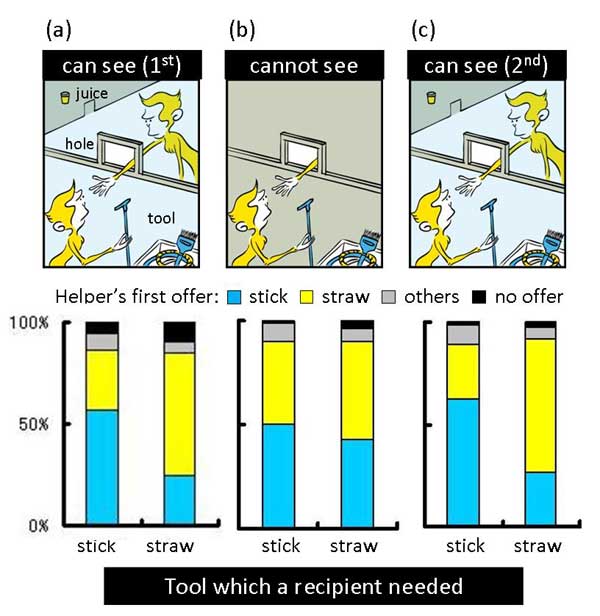|
English
2012/2/7
「相手の状況に合わせたチンパンジーの手助け行動」
チンパンジーは相手が何を必要としているかを理解し、それにあわせて利他行動を柔軟に変化させるのだろうか。本研究では、利他行動の文脈におけるチンパンジーの他者理解についてより詳細に検討した。
隣接する2つのブースのうち、片方には道具使用場面(ステッキ使用場面あるいはストロー使用場面)を設定し、もう片方のにはステッキ・ストローを含む7つの道具を与えた。ブース間パネルが透明な条件(「見える」条件)と不透明な条件(「見えない」条件)を48試行ずつ交互におこなったところ、どちらの条件でも道具使用場面の個体が穴から手を伸ばして道具を要求する行動がみられた。
しかし、渡し手の道具選択には2条件間に違いがみられ、「見える」条件では相手の状況にあわせて渡す道具の割合を有意に変化させていたのに対し、「見えない」条件ではそのような適切な道具選択ができなかった。5個体中1個体は「見えない」条件でも適切な道具を選択できていたが、この個体は道具を渡す前に穴から相手ブースを覗き見したあとに道具を選択して渡していた。
これらの結果から、チンパンジーが相手の置かれている状況を見て相手の欲求を理解し、それに応じて利他行動を柔軟に変化させていることが示めされた。同時に、相手の状況を理解していても、自発的には手助けしないことも示唆される。チンパンジーの利他行動の生起には状況の理解と要求の理解が別々かつ相補的に働いている可能性が考えられる。
Can see条件(Video 1.wmv)は、相手の道具使用状況がわかる場面です。このビデオではパン(右)はストローを必要としています。ストローを使えば壁に設置されたボトルからジュースが飲めます。パル(左)はしばらく遊んでいましたが、要求に応じてストローを選んで渡しました。
Cannot see条件(Video 2.wmv)は、相手の状況が見えない場面です。このビデオではクロエ(右)はステッキを必要としています。しかし、クレオ(左)はストロー・ホース・ハケの順に渡し、それでも要求が続いたので最終的にはステッキを渡しました。
野生動物研究センターのページ

"Flexible helping with understanding of
conspecifics’ goals in chimpanzees"
Humans extensively help others altruistically, which plays an
important role in maintaining cooperative societies. Although some
non-human animals are also capable of helping others altruistically,
humans are considered unique in our voluntary helping and the variety of
helping behaviors we demonstrate. Many still believe that this is
because only humans can understand others’ goals due to our unique
theory of mind abilities, especially shared intentionality. However, we
know little of the cognitive mechanisms underlying helping in non-human
animals, especially if and how they understand others’goals. The
present study provides the empirical evidence for flexible targeted
helping pending on conspecifics’ needs in chimpanzees. The subjects of
this study selected an appropriate tool from a random set of seven
objects to transfer to a conspecific partner confronted with differing
tool-use situations, indicating that they had an understanding of what
their partner needed. This targeted helping, i.e. selecting the
appropriate tool to transfer, was observed only when the helpers could
visually assess their partner’s situation. If
visual access was obstructed, the chimpanzees still tried to help their
partner upon request, but failed to select and donate the appropriate
tool needed by their partner. These results suggest that the limitation
in chimpanzees’ voluntary helping is not solely due to their failure
in understanding others’ goals. Chimpanzees can understand
conspecifics’ goals and demonstrate cognitively advanced targeted
helping as long as they are able to visually evaluate their conspecifics’
predicament. Yet, they will seldom help others without direct request
for help.
|







